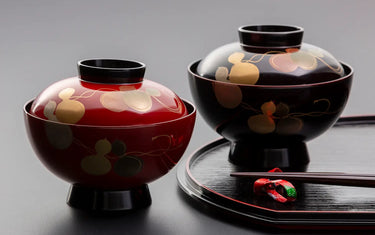Japanese traditional lacquerware called "shikki" has been a part of Japanese culture since approximately 9000 years ago.
Japanese lacquerware is one of the oldest traditional art crafts in the world. Its rich colors and shiny appearance still seduce many people today.
In this article, we will talk about shikki lacquerware, and its unique and functional characteristics that other materials, such as metals, plastics or ceramics don't possess.
The product we used:
What is Shikki lacquerware?

Shikki lacquerware are objects or utensils coated with refined resin, harvested from lacquer trees. Mixing it with iron powder or other color pigments, resin coating can add beautiful colors to the objects when dried.
Lacquer contains an organic chemical called urushiol, as well as some rubber and some enzymes.
When applied on the surface of an object, enzymes in lacquer react to the moisture in the air, hardening the liquid urushiol. Lacquer coating thus hardens and protects any object or utensil for a longer use.
Because lacquer coating makes objects hard and durable, they can resist under various conditions. It is more resistant than modern chemical coating and settles better on the surface. It repels water, resists heat and corrosion as well.
It also has a high-resistance to acids, alkalis, alcohol and salt.
Lacquer coating is known for its unique shiny appearance with rich and elegant colors.
The dark and rich color of lacquer is well-known in Japan. It is often referred to as "pitch-black darkness like lacquer (Shikkoku no yami)" in Japanese everyday idiom.
Because of its unique appearance and rich brilliance, lacquerware is used on luxurious items.
How to use Shikki lacquerware

Lacquerware comes in different forms: soup bowls for serving miso soup, rice bowls, multi-tiered Jubako boxes for serving Japanese New Year dishes, small plates, and teacups etc.
Serving dishes on lacquerware, the food looks luxurious and appetizing. They are used to serve soup, vinegared salad, deep fried meat or fish.
Be careful, however, when serving extremely hot deep fried food or boiling soup. The sudden change of temperature may cause the colors to fade.
How to clean Shikki lacquerware
After each use, wash the lacquerware gently with a soft dish sponge using dishwashing liquid.
Wipe off moisture with a cloth right after washing. Lacquer coating would last longer if you wipe dry instead of leaving them dry naturally. Since lacquer coating repels water well, you can see how easy it is to wash them.
Avoid putting them in a dishwasher where the temperature goes up high.
How to store Shikki lacquerware
Lacquerware is durable and lasts for a long time, but its only nemesis is the UV rays. The direct sunlight may cause the structure of lacquer coating to alter or the color to fade, so keep them out of the direct sunlight when you store.
To prevent damaging lacquerware, avoid stacking them on/under ceramic bowls. If you want to stack lacquerware bowls or dishes in storage, it is recommended to put a piece of soft cloth or paper between them.
Lacquerware may also deteriorate in a dry place. When you don't use them for a long period of time, put a glass of water next to them to avoid the air to dry.
Further instructions
You cannot use lacquerware over direct heat, in a microwave or in an oven. As we mentioned earlier, avoid putting them in a dishwasher. It is also recommended to avoid the sudden change of temperature by putting something extremely hot.
Although it is rare, some people might experience a skin rash when touching lacquerware which has just been coated recently. In case you experience some symptoms, stop using it immediately and consult your doctor.
You might notice a strong smell of lacquer when you open a package. It is completely normal and doesn't affect the quality of the products. The smell will eventually fade away as you use them. If you want to remove the smell right away, wash them in lukewarm water and dry them well.
Beautiful Shikki lacquerware for your table

Lacquerware utensils have a unique shiny and elegant appearance that no other utensil has.
You can create an elegant Japanese style table with foods served on gorgeous lacquerware dishes, created by one of Japan's proud art crafts.
Lacquerware is perfect for serving special dishes. It is also well-appreciated for gifts. Enjoy the Japanese shikki lacquerware to decorate your table.














